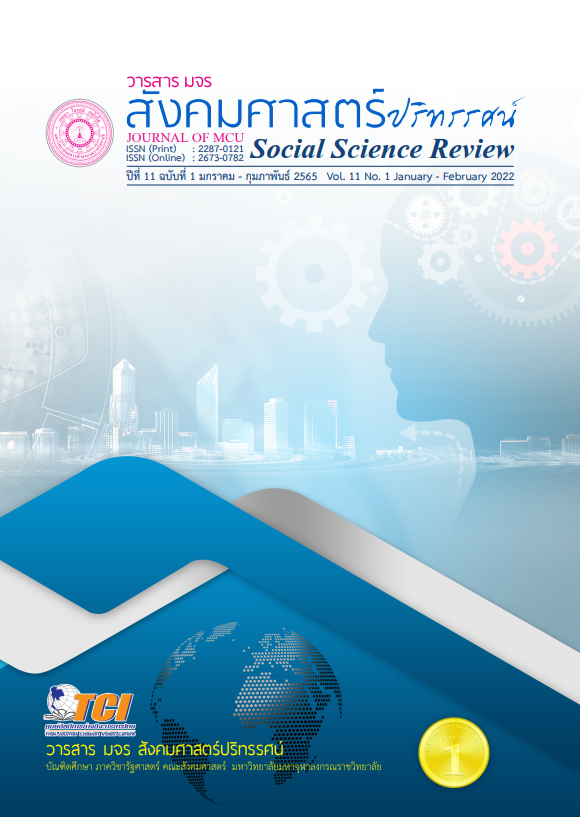รูปแบบการพัฒนาที่พักสงฆ์เพื่อยกฐานะเป็นวัดในพระพุทธศาสนาของคณะสงฆ์ จังหวัดราชบุรี
คำสำคัญ:
รูปแบบการพัฒนา, ที่พักสงฆ์, จังหวัดราชบุรีบทคัดย่อ
บทความวิจัยนี้มีวัตถุประสงค์เพื่อศึกษาสภาพปัจจุบัน องค์ประกอบ และนำเสนอรูปแบบ เป็นการวิจัยเชิงคุณภาพ เก็บข้อมูลภาคสนามโดยการสัมภาษณ์เชิงลึกกับผู้ให้ข้อมูลสำคัญ 25 รูป/คน ได้ใช้แบบสัมภาษณ์แบบมีโครงสร้าง ที่มีค่าดัชนีวัดความเที่ยงตรงเชิงเนื้อหาทั้งฉบับ (S-CVI) เท่ากับ 1.00 เป็นเครื่องมือในการเก็บรวบรวมข้อมูล และการสนทนากลุ่มเฉพาะร่วมกับผู้ทรงคุณวุฒิ จำนวน 8 รูป/คน วิเคราะห์ข้อมูลด้วยเทคนิคการวิเคราะห์เนื้อหาประกอบบริบท
ผลการวิจัยพบว่า 1. ผู้ปกครององค์กรคณะสงฆ์ในพื้นที่ดูแลเอาใจใส่อย่างใกล้ชิด แต่ที่พักสงฆ์บางแห่งมีปัญหาทางการเงิน ประชาชนในทุก ๆ พื้นที่ต้องการมีวัดประจำชุมชน กระบวนการพิจารณาอนุญาตให้ใช้ที่ดินในกรรมสิทธิ์ของหน่วยงานราชการต่าง ๆ มีระเบียบที่เคร่งครัดและขั้นตอนดำเนินงานจำนวนมาก เป็นต้น 2. องค์ประกอบในการพัฒนาที่พักสงฆ์เพื่อยกฐานะเป็นวัดในพระพุทธศาสนาของคณะสงฆ์จังหวัดราชบุรี ได้แก่ ด้านบุคคล ด้านการเงิน ด้านวัสดุสิ่งของและสถานที่ และด้านการจัดการ 3. รูปแบบการพัฒนา เป็นรูปแบบของการจัดการที่พักสงฆ์ให้มีความพร้อมสำหรับการยกฐานะขึ้นวัดในพระพุทธศาสนา ตาม “กฎกระทรวง การสร้าง การตั้ง การรวม การย้าย และการยุบเลิกวัด การขอรับพระราชทานวิสุงคามสีมา และการยกวัดร้างขึ้นเป็นวัดมีพระภิกษุอยู่จำพรรษา พ.ศ. 2559” โดยเน้นการพัฒนาความสัปปายะทั้ง 7 ที่เกื้อกูลต่อการสร้างความพร้อมสำหรับการยกฐานะขึ้นวัดในพระพุทธศาสนา
เอกสารอ้างอิง
ธงชัย สันติวงษ์. (2537). องค์การและการบริหาร (พิมพ์ครั้งที่ 9). กรุงเทพฯ: ไทยวัฒนาพานิช.
บุญเริง อรุณรัตน์. (2549). ความคิดเห็นของกำนันผู้ใหญ่บ้านต่อการอนุรักษ์ทรัพยากรป่าไม้ของสำนักสงฆ์ในจังหวัดขอนแก่น (วิทยานิพนธ์วิทยาศาสตรมหาบัณฑิต สาขาวิชาส่งเสริมการเกษตร). ขอนแก่น: มหาวิทยาลัยขอนแก่น.
ประยุทธ์ เจริญสวัสดิ์. (2540). การบริหารงานบุคคล. กรุงเทพฯ: กรมพลศึกษา กระทรวงศึกษาธิการ.
พระครูสันติธรรมาภิรัต (บุญชัย สนฺติกโร). (2557). การพัฒนารูปแบบการปกครองคณะสงฆ์ในเขตปกครองคณะสงฆ์ภาค 15 (วิทยานิพนธ์พุทธศาสตรดุษฎีบัณฑิต สาขาวิชาการจัดการเชิงพุทธ). พระนครศรีอยุธยา: มหาวิทยาลัยมหาจุฬาลงกรณราชวิทยาลัย.
พระสิทธินิติธาดา (ชลัท โชติทตฺโต). (2557). สถานภาพทางกฎหมายของวัดที่มิได้รับพระราชทานวิสุงคามสีมาและสำนักสงฆ์ (รายงานการวิจัย). พระนครศรีอยุธยา: มหาวิทยาลัยมหาจุฬาลงกรณราชวิทยาลัย.
พิทักษ์ อินทิยศ. (2546). ปัญหาม้งอพยพสำนักสงฆ์ถ้ำกระบอกกับผลกระทบต่อความสัมพันธ์ระหว่างประเทศไทยและ สปป.ลาว (วิทยานิพนธ์ศิลปศาสตรมหาบัณฑิต สาขาวิชาภูมิภาคศึกษา). เชียงใหม่: มหาวิทยาลัยเชียงใหม่.
สำนักงานจังหวัดราชบุรี. (2562). ข้อมูลทั่วไปจังหวัดราชบุรี. ราชบุรี : สำนักงานจังหวัดราชบุรี.
สุธี สุทธิสมบูรณ์ และสมาน รังสิโยกฤษฎ์. (2541). หลักการบริหารเบื้องต้น (พิมพ์ครั้งที่ 17). กรุงเทพฯ: สำนักพิมพ์ ก.พ.
Stephen, P.R. & Coulter, M. (2002). Management (7th ed). New Jersey: Prentice Hall International Inc.
ดาวน์โหลด
เผยแพร่แล้ว
รูปแบบการอ้างอิง
ฉบับ
ประเภทบทความ
สัญญาอนุญาต
ลิขสิทธิ์ (c) 2022 วารสาร มจร สังคมศาสตร์ปริทรรศน์

อนุญาตภายใต้เงื่อนไข Creative Commons Attribution-NonCommercial-NoDerivatives 4.0 International License.
เพื่อให้เป็นไปตามกฎหมายลิขสิทธิ์ ผู้นิพนธ์ทุกท่านต้องลงลายมือชื่อในแบบฟอร์มใบมอบลิขสิทธิ์บทความให้แก่วารสารฯ พร้อมกับบทความต้นฉบับที่ได้แก้ไขครั้งสุดท้าย นอกจากนี้ ผู้นิพนธ์ทุกท่านต้องยืนยันว่าบทความต้นฉบับที่ส่งมาตีพิมพ์นั้น ได้ส่งมาตีพิมพ์เฉพาะในวารสาร มจร สังคมศาสตร์ปริทรรศน์ เพียงแห่งเดียวเท่านั้น หากมีการใช้ภาพหรือตารางหรือเนื้อหาอื่นๆ ของผู้นิพนธ์อื่นที่ปรากฏในสิ่งตีพิมพ์อื่นมาแล้ว ผู้นิพนธ์ต้องขออนุญาตเจ้าของลิขสิทธิ์ก่อน พร้อมทั้งแสดงหนังสือที่ได้รับการยินยอมต่อบรรณาธิการ ก่อนที่บทความจะได้รับการตีพิมพ์ หากไม่เป็นไปตามข้อกำหนดเบื้องต้น ทางวารสารจะถอดบทความของท่านออกโดยไม่มีข้อยกเว้นใดๆ ทั้งสิ้น





